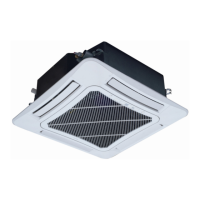Multi Variable Air Conditioners Ducted Type Indoor Unit
10
4.2 Refrigerant Pipe Connection
(1) Aim the flaring port of copper pipe at the center of screwed joint and then tighten the flaring
nut with hand as shown in Fig.4.2.1.
(2) Tighten the flaring nut with torque wrench.
Fig.4.2.1
Torque for tightening nut
Pipe diameter mm(inch) Torque(N•m)
Φ6.35(1/4) 15~30
Φ9.52(3/8) 35~40
Φ12.7(1/2) 45~50
Φ15.9(5/8) 60~65
Φ19.05(3/4) 70~75
(3) Use pipe bend when bending the pipe and the bending angle should not be too small.
(4) Wrap the connection pipe and joint with sponge and then tie them firmly with tape.
4.3 Drainage Pipe Installation and Drainage System Testing
4.3.1 Notice for Installation of Drain Pipe
(1) It is not allowed to connect the condensate drain pipe into waste pipe or other pipelines
which are likely to produce corrosive or peculiar smell to prevent the smell from entering
indoors or corrupt the unit.
(2) It is not allowed to connect the condensate drain pipe into rain pipe to prevent rain water
from pouring in and cause property loss or personal injury.
(3) Condensate drain pipe should be connected into special drain system for air conditioner.
(4) The drainage pipe should be short and the gradient downwards should be at least 1%~2% in
order to drain condensation water smoothly.
(5) The diameter of drainage hose should be bigger or equal to the diameter of drainage pipe
joint.
(6) Install drainage pipe according to the following Fig. and arrange insulation to the drainage
pipe (Fig.4.3.1). Improper installation may lead to water leakage and damp the furniture and
other things in the room.
(7) You can buy normal hard PVC pipe used as the drainage pipe. During connection, insert the
end of PVC pipe into the drainage hole and then tighten it with drainage hole and wire binder.
Can’t connect the drainage hole and drainage hole with glue.

